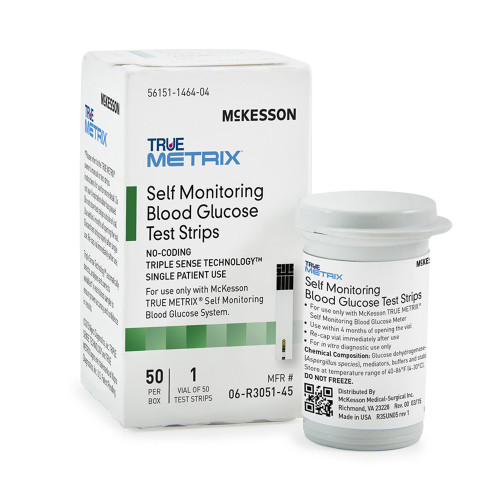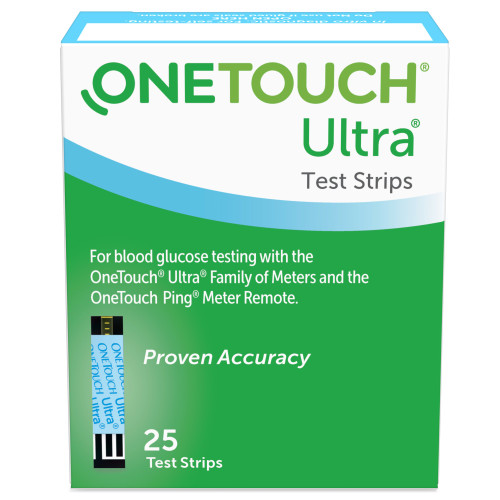-

Embrace
Embrace Glucose Test Strips
The Embrace Talk Blood Glucose Test Strips has instant three step verification that ensures accurate results every time. (1) Confirms test strip is positioned correctly (2) Pinpoint technology detects sample (3) and fill detection verifies sample is...
$20.99 -

Embrace
Embrace Glucose Test Strips 25 Strips per Pack
The Embrace Talk Blood Glucose Test Strips has instant three step verification that ensures accurate results every time. (1) Confirms test strip is positioned correctly (2) Pinpoint technology detects sample (3) and fill detection verifies sample is...
$10.99 -

EmbraceWave
EmbraceWave Glucose Test Strips 50 Strips per Pack
The EmbraceWAVE+ System uses EmbraceWAVE test strips that feature Three-Step Verification – ensuring accurate results every time. These strips only require a small sample and returns test results in 5 seconds. One box includes 50 test strips.Confirms...
$19.18 -

Embrace
Embrace Glucose Test Strips 50 Strips per Pack
Embraceª Test Strips use gold electrode test strips technology for reliability and accuracy.Accurate results within 5 seconds Auto coding
$16.20 -

Unistrip
Unistrip Glucose Test Strips, Accurate and Fast Results
Unistrip1™ test strips work with the OneTouch® Ultra®, OneTouch® Ultra®2, OneTouch® UltraSmart®, and OneTouch® UltraMini® meters. The capillary action automatically draws the blood sample into the test strip. Unistrip Test Strips are approved for...
$20.38 -

McKesson
McKesson TRUE METRIX Self-Monitoring Blood Glucose Test Strips, Diabetic Testing Supplies
Package Count: 1200. For use with #06-RE4051-43 McKesson TRUE METRIX® Self-Monitoring System, and #06-R5051-1, #06-R5051-2 and #06-R5051-3 McKesson TRUE METRIX® Controls.For use with #06-RE4051-43 McKesson TRUE METRIX® Self-Monitoring System, and...
$242.00 -

McKesson
McKesson TRUE METRIX Blood Glucose Test Strips for Diabetes Monitoring
For use with #06-RE4051-43 McKesson TRUE METRIX Self-Monitoring System, and #06-R5051-1, #06-R5051-2 and #06-R5051-3 McKesson TRUE METRIX ControlsFor use with #06-RE4051-43 McKesson TRUE METRIX Self-Monitoring System, and #06-R5051-1, #06-R5051-2 and...
As low as $15.13 -

Accu-Chek
Accu-Chek Glucose Test Strips 100 Strips per Pack
Package Count: 100. For use with Accu-Chek Guide Blood Glucose Monitoring System
$74.25 -

McKesson
McKesson TRUE METRIX PRO Blood Glucose Test Strips for Diabetes Monitoring
Select Count: 50 Strips, 100 Strips, or 1200 Strips. This set of Test Strips for Blood Glucose helps you monitor your health. They include instructions to make it easy to properly use and read them. These TRUE METRIX® PRO test strips by McKesson are...
As low as $18.31 -

Advocate
Advocate Redi-Code+ Blood Glucose Test Strips - No Coding Required
Used with all Advocate Red-Code Plus Glucose Meters to quantitatively measure glucose levels in fresh capillary whole blood samples An extremely small sample is obtained from the fingertips or from Alternate Sites (palm, forearm, upper arm, thigh or calf)
$11.34 -

OneTouch
OneTouch Ultra 2 Blood Glucose Test Strips, Diabetes Supplies
DoubleSure® Technology automatically checks each blood sample twice FastDraw™ capillary action draws sample in less than 1 second Provide visual confirmation of adequate blood sample Stands behind eight years of proven accuracy
$74.89 -

Assure
Assure Blood Glucose Test Strips for Assure Prism Glucose Monitoring System, 100 Strips
The Assure Prism multi Blood Glucose Monitoring System provides users with a fast, accurate and easy way to monitor their blood glucose levels.Precise and accurate test strip chemistry is augmented by auto-coding reducing the chance of error
$31.32
Glucose Meter Test Strips

Glucose Meter Test Strips
Diabetic test strips are a crucial component to effectively managing your blood sugar. Without test strips, your glucose meter does not function.
What Are Glucose Meter Test Strips?
Test strips are ingenious little pieces of technology that, when combined with the technology in your glucose meter, allow the meter to measure the amount of glucose present in your blood.
How to Use a Glucose Test Strip
To use a test strip, you must first insert the correct end into your glucose meter. You then prick your finger with a lancet to draw a drop of blood. You may need to squeeze your finger to get enough blood. You then transfer the blood drop to the exposed edge of the test strip, then wait for the meter to display your blood glucose reading.
Make sure to read the instructions that come with the meter to operate it correctly and get an accurate reading.
How Do Test Strips Work?
Diabetes test strips are composed of several layers. One of these is an extremely thin gold that acts as a circuit board. Another is impregnated with chemicals that react when exposed to a blood drop. This chemical reaction creates a minute electrical current.
The more sugar there is in your blood, the more intense the chemical reaction is and the stronger the electrical current. The electrical current travels from the testing strip to the glucose meter, which measures the speed of the current and uses this to calculate the amount of glucose present in your blood.
How Accurate Are Test Strips?
Some glucose meters and test strips are more accurate than others, so doing your homework regarding meters before purchasing is a good idea. However, the FDA states that meters and strips on the market should give you a reading within 20% of ideal lab values 99 percent of the time.
Storing Glucose Test Strips
How you store your test strips can affect the accuracy of your readings.
Getting the Most Accurate Information from Your Test Strips
Along with proper storage, there are a few other simple guidelines for achieving the most accurate test results:
Diabetic test strips are a crucial component to effectively managing your blood sugar. Without test strips, your glucose meter does not function.
What Are Glucose Meter Test Strips?
Test strips are ingenious little pieces of technology that, when combined with the technology in your glucose meter, allow the meter to measure the amount of glucose present in your blood.
How to Use a Glucose Test Strip
To use a test strip, you must first insert the correct end into your glucose meter. You then prick your finger with a lancet to draw a drop of blood. You may need to squeeze your finger to get enough blood. You then transfer the blood drop to the exposed edge of the test strip, then wait for the meter to display your blood glucose reading.
Make sure to read the instructions that come with the meter to operate it correctly and get an accurate reading.
How Do Test Strips Work?
Diabetes test strips are composed of several layers. One of these is an extremely thin gold that acts as a circuit board. Another is impregnated with chemicals that react when exposed to a blood drop. This chemical reaction creates a minute electrical current.
The more sugar there is in your blood, the more intense the chemical reaction is and the stronger the electrical current. The electrical current travels from the testing strip to the glucose meter, which measures the speed of the current and uses this to calculate the amount of glucose present in your blood.
How Accurate Are Test Strips?
Some glucose meters and test strips are more accurate than others, so doing your homework regarding meters before purchasing is a good idea. However, the FDA states that meters and strips on the market should give you a reading within 20% of ideal lab values 99 percent of the time.
Storing Glucose Test Strips
How you store your test strips can affect the accuracy of your readings.
- Store at room temperature.
- Do not refrigerate or store on a high shelf where they may get hot, as extreme temperatures can damage them.
- Keep your test strips in a sealed vial. They will become unusable if exposed to humidity.
- Don’t use contaminated test strips; if they’ve come in contact with food, liquids, dirt, or any other foreign substance, your reading may be wildly inaccurate.
- Don’t use test strips that are damaged in any way.
Getting the Most Accurate Information from Your Test Strips
Along with proper storage, there are a few other simple guidelines for achieving the most accurate test results:
- Only use test strips intended for your brand and model of meter. Just because a strip will fit in the meter doesn’t mean it will work.
- Don’t use test strips that are past their expiration date.
- You may need to recalibrate your meter when you open a new box of test strips. Check the instructions.
- Make sure your meter is clean, and your hands are freshly washed. Both a dirty meter and unwashed hands can skew your results.
- Make sure your hands are dry before you test. Wet fingers can lead to an inaccurate result.
